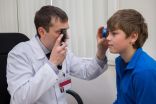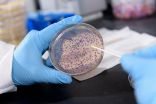Gene may predict severity of post-traumatic stress disorder
2015-09-01
(Press-News.org) (Boston)--A gene linked in previous research, appears to predict more severe post-traumatic stress disorder (PTSD) symptoms as well as a thinner cortex in regions of the brain critical for regulating strong emotions and coping with stressful experiences. This study is believed to be the first to show that the spindle and kinetochore-associated complex subunit 2 (SKA2) gene may play a role in the development of PTSD.
Led by researchers at Boston University School of Medicine (BUSM), the National Center for PTSD and the Translational Research Center for TBI and Stress Disorders at VA Boston Healthcare System, the study appears online in the journal Molecular Psychiatry.
PTSD is prevalent among veterans. Eleven to 20 percent of veterans who served in Operations Iraqi Freedom and Enduring Freedom have experienced PTSD in a given year. Studies suggest that warzone trauma, PTSD symptoms and other post-deployment mental health problems put veterans at heightened risk for suicide relative to the general population.
The researchers performed MRI brain scans and collected blood samples from 200 veterans returning from the recent conflicts in Iraq and Afghanistan. They looked at whether a chemical change (methylation) in the function of the SKA2 gene measured in blood predicted the thickness of brain cortex (a measure of neuronal health) and psychological symptoms, specifically PTSD and depression.
"Our findings showed that an in increase in methylation of the SKA2 gene is associated with decreased cortical thickness in the prefrontal cortex, which may play a role in the development of PTSD and may explain why this gene predicts risk for mental health problems, like PTSD and suicide," explained lead and corresponding author Naomi Samimi Sadeh, PhD, assistant professor of psychiatry at BUSM and a psychologist in the National Center for PTSD at VA Boston.
According to the researchers the implications of this study are significant since it is difficult to predict who will develop PTSD following traumatic events. "These findings suggest that in the future it may be possible to use a genetic blood test to identify military personnel at risk for developing PTSD in response to warzone stressors. We hope these findings will ultimately enhance our ability to identify individuals who are at risk for this disorder by using information about biology to improve diagnosis," Sadeh concluded.
INFORMATION:
This research was supported in part by the NIMH grant R21MH102834 'Neuroimaging Genetics of PTSD' Mark Miller, PhD, and the Translational Research Center for TBI and Stress Disorders (TRACTS), a VA Rehabilitation Research and Development Traumatic Brain Injury
Center of Excellence (B9254-C) and the Cooperative Studies Program, Department of Veterans Affairs. This research is the result of work supported with resources and theuse of facilities at the Pharmacogenomics Analysis Laboratory, Research and
Development Service, Central Arkansas Veterans Healthcare System, Little Rock, Arkansas. This work was also supported by a Career Development Award to EJW from the United States Department of Veterans Affairs, Clinical Sciences Research and Development Program.
ELSE PRESS RELEASES FROM THIS DATE:
2015-09-01
The neutrino and its antimatter cousin, the antineutrino, are the tiniest subatomic particles known to science. These particles are byproducts of nuclear reactions within stars (including our sun), supernovae, black holes and human-made nuclear reactors. They also result from radioactive decay processes deep within the Earth, where radioactive heat and the heat left over from the planet's formation fuels plate tectonics, volcanoes and Earth's magnetic field.
Now, a team of geologists and physicists has generated the world's first global map of antineutrino emissions. ...
2015-09-01
A new study has found that the occurrence of advanced forms of a diabetic eye disease remains low among children living with diabetes, regardless of how long they have had the disease or their ability to keep blood sugar levels controlled. Researchers are therefore recommending that most children with type 1 diabetes delay annual diabetic retinopathy screenings until age 15, or 5 years after their diabetes diagnosis, whichever occurs later. Their findings were published online today in Ophthalmology, the journal of the American Academy of Ophthalmology.
It is well established ...
2015-09-01
A bacterium engineered to produce different pigments in response to varying levels of a micronutrient in blood samples could give health officials an inexpensive way to detect nutritional deficiencies in resource-limited areas of the world. This "bacterial litmus test," which currently measures levels of zinc, would require no electrical equipment and make results visible as simple color changes.
More than a billion people worldwide may be at risk for adequate zinc intake, but measuring zinc levels in blood samples currently requires sophisticated testing equipment not ...
2015-09-01
In the "NeverEnding Story", Bastian feels so involved in the narration that he experiences the same emotions as the characters (and in the end he really enters the book). What happens to the main character of Micheal Ende's book is exactly what happens to each of us when we read a novel or a short story: we literally replicate the physiological processes and emotions of the characters described in the text. Francesco Foroni, research scientist at the International School for Advanced Studies (SISSA) of Trieste, already demonstrated this phenomenon a few years ago in a study ...
2015-09-01
PULLMAN, Wash.--Washington State University researchers have found that the timing of an animal's sleep can be just as important as how much sleeps it gets.
Ilia Karatsoreos, an assistant professor in WSU's Department of Integrative Physiology and Neuroscience, shifted mice from their usual cycle of sleeping and waking and saw that, while they got enough sleep, it was of poorer quality. The animals also had a disrupted immune response, leaving them more open to illness.
Most sleep research focuses on the effects of sleep deprivation or the overall amount of sleep an animal ...
2015-09-01
A multi-disciplinary group of European researchers spanning natural science, socio-economics and law have joined forces to assess the current landscape of deep-sea research and investment in Europe. Once considered remote and inaccessible, commercial interest to exploit the deep sea (1) is rising due to economic drivers and technology developments. However, exploitation activities in the deep sea remain highly contentious, particularly regarding the potential risks and environmental impacts associated with such activities. A consultation of deep-sea stakeholders spanning ...
2015-09-01
New research from LSTM has revealed precisely how insecticide-treated bed nets are so effective against malaria mosquitoes.
Communities in the poorest countries are the most vulnerable to malaria and 90% of all malaria deaths occur in Africa. Safe, simple and affordable, long-lasting insecticidal bed nets (LLINs) are very effective in preventing malaria and have played a major part in reducing malaria deaths in Africa by over 50% since 2000 (WHO). However, as very little is known about how mosquitoes interact with nets or how LLINs do their job so effectively, how they ...
2015-09-01
Researchers at University of La Rioja (Spain) have developed a new method to eliminate artificial satellites in Highly Elliptical Orbits when they finish their mission. The methodology, which allows for a reduction of both cost and risk, has been tested with the European Space Agency INTEGRAL mission, which will re-enter into the Earth's atmosphere in order to disintegrate in 2029.
The problem of space debris is one of the main challenges that aerospace engineers have to face, due to the danger it poses to satellites. In this context, members of the Scientific Computing ...
2015-09-01
BEIJING, CHINA (1 September 2015)--At a time when the price of mutton is climbing and wool crashing, a groundbreaking new study has used advanced genetic sequencing technology to rewrite the history of sheep breeding and trading along the ancient Silk Road--insights that can help contemporary herders in developing countries preserve or recover valuable traits crucial to their food and economic security.
The new findings regarding one of the first animals ever domesticated will be published in the October print edition of the journal Molecular Biology and Evolution. They ...
2015-09-01
DENVER (Sept. 1, 2015) - While many planners focus on the threat of natural disasters to major metropolises around the world, a new study from the University of Colorado Denver shows smaller cities are often even less equipped to handle such catastrophes.
"Small cities are often far away from where decisions get made and struggle to insert themselves into the agenda of decision-making bodies," said study author Andrew Rumbach, PhD, an assistant professor at the CU Denver College of Architecture and Planning, a major center of timely, topical and relevant research. "When ...
LAST 30 PRESS RELEASES:
[Press-News.org] Gene may predict severity of post-traumatic stress disorder


